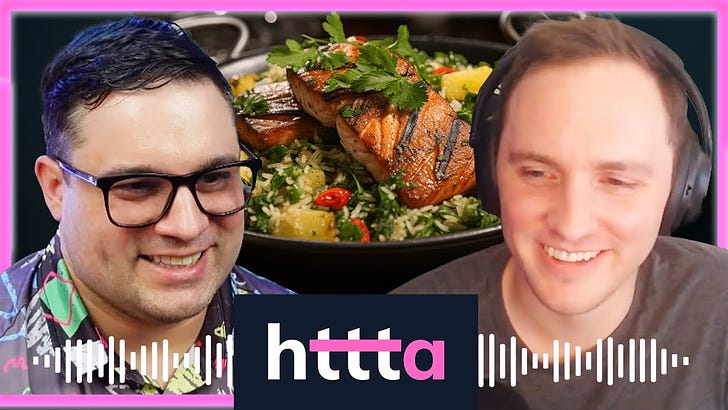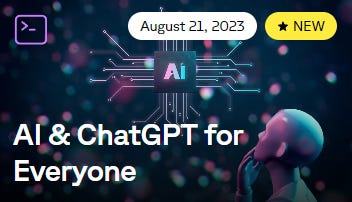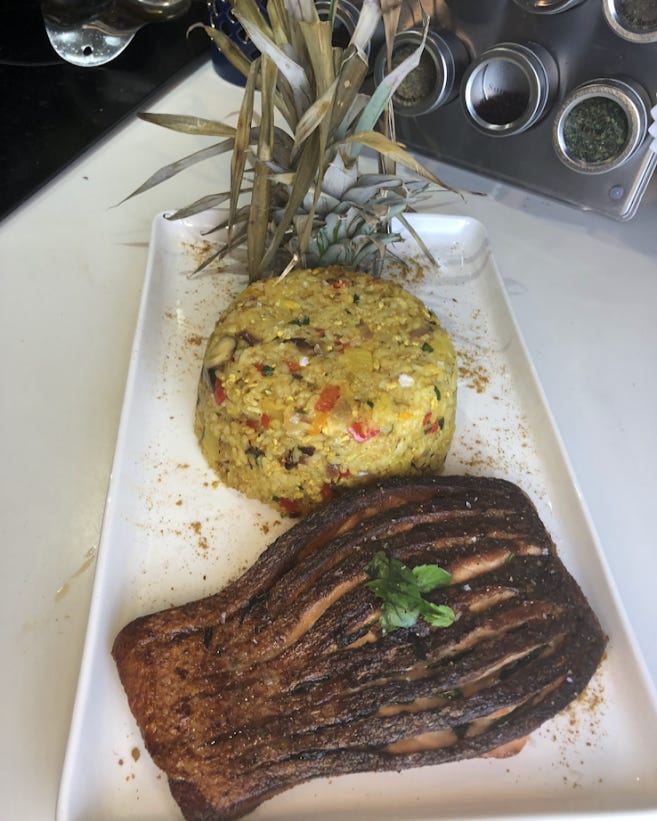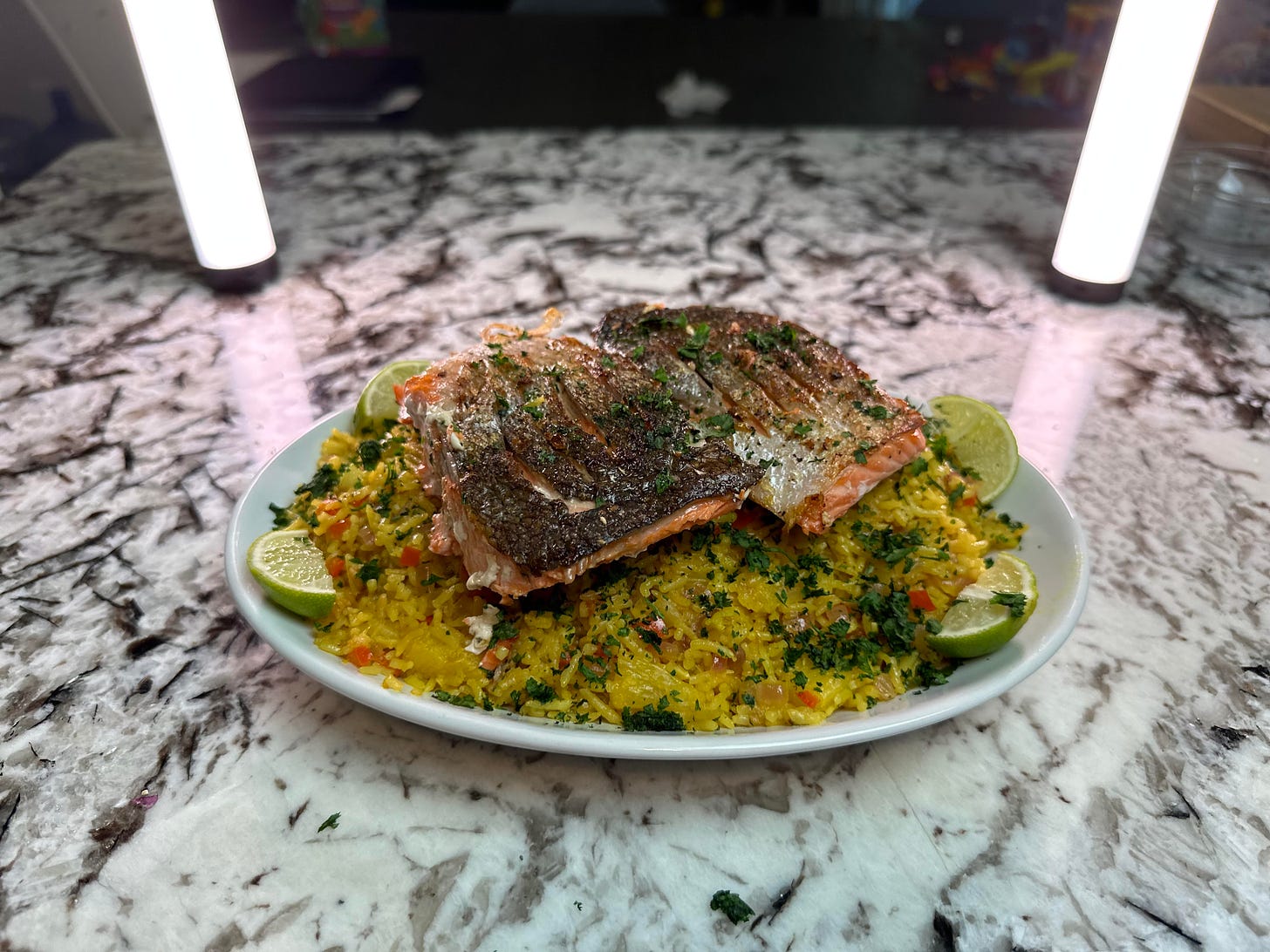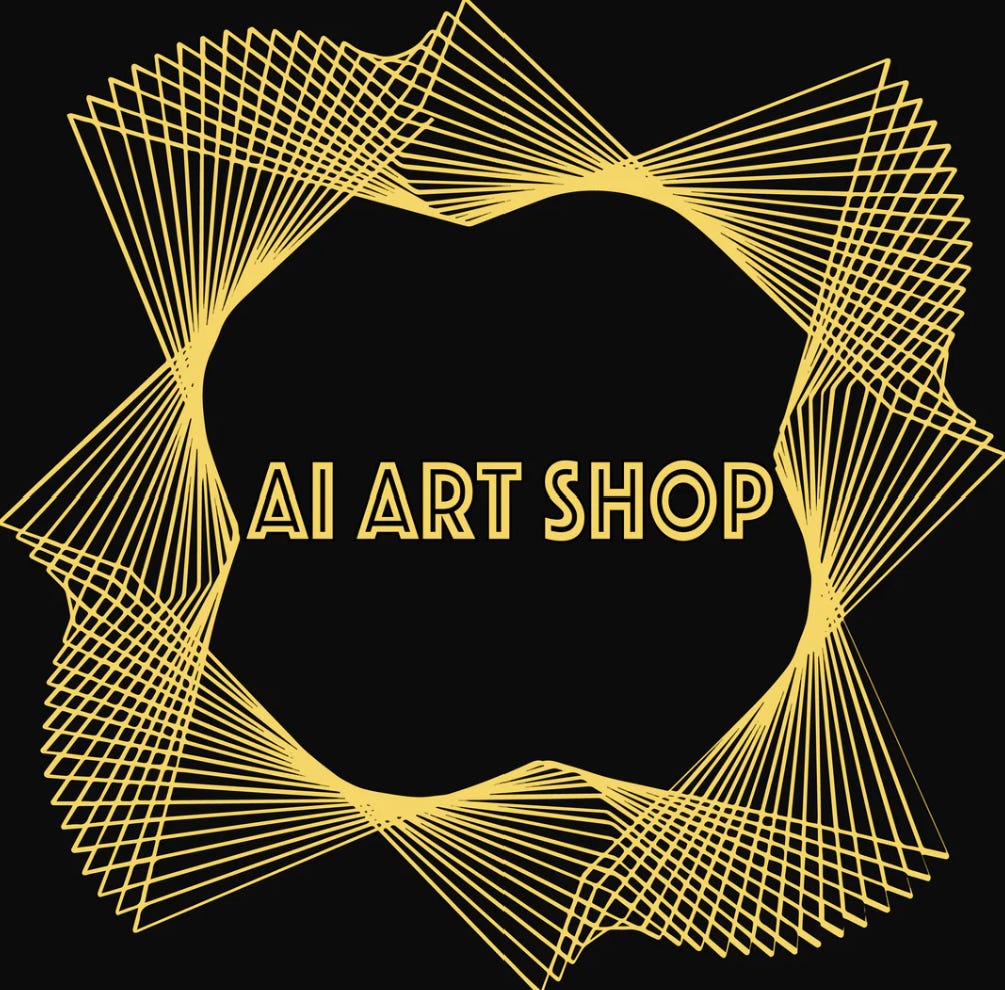EP13: TheKitchen.AI: How Keegan Dargie Transforms Recipes with the Power of AI and Generative AI in Fashion
Generative AI makes a spicy meat-a-ball!
Howdy, prompt engineers and AI enthusiasts!
In this week’s issue…
In the latest episode of HTTTA, we went on a journey where we explored the incredible potential of AI in the kitchen. 🤖👩🍳, We introduces the future of culinary innovation with the creator of thekitchen.ai, Keegan Dargie! 🍽️💡 Discover how generative AI, like GPT-4, is revolutionizing recipe creation, adapting to specific dietary restrictions, and even generating stunning food images. 😮📸 Get ready to tantalize your taste buds with the mouthwatering "Sizzling Samba Salmon with Fiery Pineapple Pilaf" recipe, expertly modified by AI for maximum flavor. 🌶️🐟🍍 From beginner to master-level recipes, this game-changing kitchen AI has it all. 🎉 Ready to revolutionize your cooking game? 🌟 Don't miss out on this podcast episode that will leave you hungry for more! 🎧🍽️ Happy Prompting Everybody! Happy Prompting Everybody!
Key Take Aways from the Podcast:
1. The power of generative AI and large language models: The episode showcases the our guest’s experience working with AI, specifically generative AI and large language models like GPT-3. The potential and progress of AI in understanding specific topics within cooking and cuisine, such as dietary restrictions, is highlighted, along with the importance of providing clear and specific prompts to achieve better results when crafting new recipes.
2. The development of thekitchen.AI platform: Our guest Keegan discusses their project of creating a kitchen AI system that generates custom recipes, provides step-by-step instructions, and even generates AI-generated images of dishes. The automation of recipe creation and promotion on social media, as well as the customization options for health conditions and dietary preferences, are key features of the platform.
3. Collaboration between humans and AI: The episode emphasizes the collaboration between humans and AI in various creative fields, such as fashion and cooking. It highlights the impressive creativity and expertise of humans, while also showcasing how AI can enhance and streamline processes, provide recommendations, and offer new perspectives in these fields. Keegan has a plan to organize a chef versus AI competition further highlighting this collaboration and exploration of the capabilities of AI in the culinary world.
The Kitchen AI
ca.la AI Fashion Design Tool
Prompt Perfect: FOR 15% OFF,
Use this link https://bit.ly/3Chmc16 and the code 'httta' at the checkout!
MidJourney Master Reference Guide: bit.ly/3obnUNU
ChatGPT Master Reference Guide: bit.ly/3obo7AG
Learn Prompting: https://learnprompting.org/
Discord (Goda Go#3156 & Commordore_Wesmardo#2912)
Goda Go on Youtube: /@godago
Wes the Synthmind's everything: https://linktr.ee/synthminds
1. We're Live on CoRise! Learn Prompting Course: AI & ChatGPT for Everyone
Wes will be teaching AI & ChatGPT for Everyone, a cutting-edge course that dives deep into the world of language models and chatbots, with a specific focus on leveraging the power of LLMs like ChatGPT. Designed for individuals across various domains, this course equips learners with the knowledge and skills to harness the capabilities of AI-driven conversation engines. Through hands-on exercises and real-world examples, participants will learn how to optimize prompts for different purposes, whether it's writing persuasive copy, building interactive chatbots, or enhancing customer support systems.
The course, which is taught by Wes with Goda participating as well, convenes August 21, 2023 and runs 3 weeks. Click here to sign up for the course, and use the code “AI4ALL” for 10% off!
2. Let’s Cook…with AI
An AI-Generative Walter White aka Heisenberg Commercial for Broccoli—-Let’s Cook
Innovation in the culinary world knows no bounds. From notable chefs pushing the boundaries of flavor profiles to the emergence of fusion cuisine, the art of cooking has always evolved with changing times. However now, a new ingredient has been added to the mix – Artificial Intelligence. This cutting-edge technology is revolutionizing the way we approach culinary creation, enabling chefs and home cooks alike to explore uncharted territories of flavor, efficiency, and personalization. Let’s explore how cooking with AI is not only redefining culinary creativity but also enhancing operational efficiency in the kitchen.
With advancements in AI technology, the capabilities of culinary applications have expanded exponentially. Chefs, recipe creators, and food enthusiasts are now leveraging AI-powered platforms like thekitchen.ai to develop personalized recipes, generate innovative flavor combinations, and automate complex cooking processes. The fusion of human expertise and AI's computational power has unlocked new realms of culinary possibilities.
AI's ability to generate unique and enticing dishes is truly remarkable. By analyzing vast amounts of culinary data, AI systems can suggest novel ingredient combinations, innovative cooking techniques, and fusion cuisines that transcend traditional boundaries. The creative collaboration between humans and AI is propelling culinary innovation to unimaginable heights. Take, for example, theKitchen.AI system developed by one visionary food enthusiast. Keegan Dargie. By utilizing AI language models like GPT-4, this system can curate customized recipes based on specific dietary restrictions, health conditions, or personal preferences. The platform's ability to generate various flavor variations, pairings, and even provide step-by-step instructions for modifying dish profiles showcases AI's capacity to revolutionize creative recipe development.
Efficiency is a critical aspect of any successful endeavor in the culinary world. AI-powered platforms are significantly streamlining the cooking process, reducing manual labor, and optimizing kitchen operations. By automating recipe creation and modification, AI eases the burden on chefs, empowering them to focus more on the artistic elements of their craft. For instance, AI can generate alternative ingredient options for specific dietary restrictions, saving considerable time spent on searching and sourcing these ingredients manually. AI algorithms can also analyze vast culinary datasets and identify trends, enabling chefs to adapt to evolving consumer preferences with agility. This automated approach not only saves time but increases the efficiency of operations within professional kitchens and home environments.
Successful implementations of AI in the culinary world depend on a harmonious collaboration between AI algorithms and human chefs. Chefs bring their culinary expertise, unique flavor knowledge, and artistic sensibilities to the table, while AI technology assists in expanding possibilities, automating repetitive tasks, and offering data-driven insights. This collaboration is exemplified by AI-generated food images, where AI systems can interpret ingredients and cooking techniques to create visually stunning representations of dishes. Through iterative processes and experimentation, human chefs can refine these images, combining unexpected elements to craft visually appealing visual representations of their culinary creations.
The emergence of AI in the culinary world represents a paradigm shift in how we approach cooking, unleashing unprecedented creativity, and efficiency. By working hand in hand with AI technology, chefs and home cooks are pushing culinary boundaries, experimenting with new flavors, and streamlining kitchen operations. As AI continues to evolve, the possibilities for culinary exploration and innovation are limitless. Embracing this collaboration between humans and AI, we can revolutionize the way we cook, create, and experience the flavors of the world.
3. Research Corner: Application of Artificial Intelligence in Food Industry—a Guideline
Mavani NR, Ali JM, Othman S, Hussain MA, Hashim H, Rahman NA. Application of Artificial Intelligence in Food Industry—a Guideline. Food Eng Rev. 2022;14(1):134–75. doi: 10.1007/s12393-021-09290-z. Epub 2021 Aug 9. PMCID: PMC8350558.
While generative AI is new to the kitchen, AI has been used in the food industry for years. The use of artificial intelligence (AI) in the food industry has become increasingly prevalent in order to meet the growing demands for food production. AI systems have been implemented in various tasks such as determining food quality, controlling tools, classifying food, and making predictions. These intelligent systems offer several advantages, including improved accuracy, cost reduction, and enhanced overall performance.
There are several AI techniques that have been applied in the food industry. Fuzzy logic (FL) has been used in tasks like bread making, roasting machine control, and ranking the quality attributes of cupcakes. Artificial neural networks (ANN) have been utilized to predict drying behavior, temperature variations in mushroom growing halls, and sensory quality of garlic. Machine learning (ML) techniques have been employed for predicting food insecurity, sales trends, and food waste generation. Adaptive neuro fuzzy inference system (ANFIS) techniques have been used to predict the drying behavior of onions and the stability of honey crystallization.
Furthermore, the integration of AI systems with external sensors has proven to be advantageous in real-time detection in the food industry. For instance, electronic nose and electronic tongue systems have been used for odor and taste detection, while computer vision systems have been employed for image processing and pattern recognition. Near-infrared spectroscopy (NIRS) has been utilized for non-destructive analysis of food properties. By integrating AI with these sensor systems, the food industry can significantly improve efficiency, accuracy, and overall performance in food quality control and assurance.
The use of AI in the food industry offers numerous benefits, including improved quality control, prediction accuracy, and cost reduction. The integration of AI with external sensors further enhances its capabilities and enables the industry to optimize efficiency and quality. By selecting the appropriate AI method and integrating it with sensor systems, the food industry can enhance its overall performance and meet the demands of a growing population.
4. ELI5 AI Term of the week: “What’s a Token in Large Language Models?”
let's imagine a large language model is like a very smart robot who loves to read books. This robot doesn't read the same way humans do - instead of reading word by word or sentence by sentence, it reads "tokens".
You can think of a token as a piece of a sentence. For example, in the sentence "The big blue dog", each word can be a token - so there would be four tokens: "The", "big", "blue", "dog". Sometimes, if the robot encounters a really big word it hasn't seen before, it might break it into smaller pieces, and each piece becomes a token.
So, the robot reads a whole bunch of these tokens (from books, articles, web pages) and learns to understand how these tokens usually go together. This way, it can generate new sentences when we ask it to, by deciding the most likely tokens to come next!
It's a bit like when you play with building blocks. Each block (token) is a piece of the final structure (sentence), and after playing and practicing a lot, you can predict which blocks (tokens) fit well together to make the structure (sentence) you want.
5. Our Featured Recipe, the human and AI Version of Samba Salmon with Pineapple Pilaf
The original dish Wes created served as the inspiration for AI’s take
Alright the moment you’ve been waiting for….who does it better, the human, or the AI. Who shall prevail? First, here’s AI’s take with notes from Master Chef Wes:
Sizzling Samba Salmon with Fiery Pineapple Pilaf—Dinner for 2
Sizzling Samba Salmon with Fiery Pineapple Pilaf is a dinner dish fusing Hawaiian and Thai flavors. It features a crispy-skinned salmon filet, perfectly paired with a spicy pineapple fried rice. The combination of sweet, tangy pineapple and the heat from the spices makes this dish an exotic culinary delight.
You Need This Stuff
2 Salmon filets, skin on
1 cup Pineapple, diced
1 cup Jasmine rice (Human version calls for day-old rice, better for fried rice)
2 tbsp Olive oil (Should be sesame oil, but not a big deal)
1/2 tsp Salt
1/4 tsp Black pepper
2 cloves Garlic, minced (Morrrrr garlic needed AI pleazzzz)
1 small Onion, diced
1 Red bell pepper, diced
1 Green bell pepper, diced (would sub this for a yellow bell pepper)
2 Thai chilies, finely chopped (adjust to taste)
2 tbsp Soy sauce
1 tbsp Fish sauce (optional) (Not optional, and add more)
1/2 tsp Turmeric powder (In original this was curry powder)
1/4 cup Fresh cilantro leaves, chopped for garnish
Juice of 1 Lime for seasoning the salmon and adding a tangy flavor to the pilaf
So only missing ingredients were eggs for the fried rice, and 1/2 a cup of coconut milk for sweetness and richness, but so far, AI get an A- for ingredient selection…bravo. Onto the instructions.
Rinse the salmon filets under cold water and pat dry with paper towels
(key step missing here, place the salmon skin side up in the fridge for at least an hour before…we want that crispy skin. Also I do multiple cuts in the salmon skin so there’s more places for the sale to penetrate, and to speed up cooking time.)
Place the salmon on the cutting board, skin side down (nope nope), and season with salt, black pepper, and half of the lime juice (the lime juice was the killer here. Adding acid to fish actually starts the cooking process, and will cause salmon to overcook more quickly, as well as leach out the albumin inside as the fish cooks, which makes the flavor escape and forms the gooey white stuff on your cooked salmon. Minus points for AI)
Set aside to marinate for 15 minutes (nope nope)
While the salmon is marinating, prepare your vegetables: using the chef’s knife and cutting board, dice the pineapple, onion, red bell pepper, green bell pepper, and finely chop the Thai chilies Mince the garlic cloves using a garlic press
In a small bowl mix together soy sauce, fish sauce (if using), and remaining lime juice to create a tangy sauce for later use
Heat 1 tbsp of olive oil (sesame oil) in a large skillet over medium heat Once hot, add salmon filets skin side down Cook for 4-5 minutes until skin is crispy then flip with fish spatula and cook for another 3-4 minutes until salmon is cooked through. (for crispy skin, 80% of the cooking time should be skin side down) Remove from skillet and set aside on a plate covered with foil to keep warm (should be served immediately, so do the rice first and salmon last)
In the same skillet add remaining olive oil Add diced onion and minced garlic to skillet; sauté until onion becomes translucent (about 2-3 minutes)
Add diced red bell pepper, green bell pepper to skillet; sauté for an additional 2-3 minutes until peppers are softened
Stir in chopped Thai chilies (adjust amount based on preferred spice level) followed by diced pineapple; sauté for another minute until pineapple is slightly caramelized
Transfer this mixture from skillet into a bowl temporarily
In a medium saucepan bring 2 cups of water to boil Add jasmine rice along with turmeric powder; stir well (the cooking of the rice was the main difference between the original and AI’s take. But the recipie was trying for a pilaf, and not fried rice, so we’ll call this one a draw)
Reduce heat to low cover saucepan with lid let it simmer for about 15-20 minutes or until rice is cooked
Once rice is cooked fluff it gently with fork then add sautéed vegetable-pineapple mixture back into saucepan along with prepared soy-fish-lime sauce; mix well ensuring all ingredients are combined evenly
Plate your fiery pineapple pilaf onto two plates top each serving with a cooked salmon filet garnish each plate with fresh cilantro leaves before serving
So minus points for the salmon marinade, which canceled any real chance of super crispy bacon-of-the-sea salmon skin. AI was making a pilaf, not fried rice, so no minus points. C+ for technical steps for AI.
And the final results…first, the AI-generated image:
And then Wes’s recreation of the AI recipe, complete with lighting for dramatic effect:
And the final verdict on taste…B- overall. The lime juice marinate didn’t do the salmon any favors, and it was overcooked with the instructed cooking time. The rice pilaf was pleasant, but missing some cohesion, which could have likely been achieved with the addition of eggs to the pilaf, as well as swapping the turmeric for curry powder. Yet this is certainly a flavorful dish every which way.
6. Prompts, served Hot and Fresh weekly
In this week’s episode, we got to learn all about thekitchen.ai’s “secret sauce,” which makes GenAI cook up some delicious recipes. While the magical inner workings of the back-of-the-house AI sous chefs will remain a trade secret of Keegan and his team at thekitchen.ai, here’s a full-loaded prompt that pays homage to thekitchen.ai. Bon Appetit.
I want you to act as an expert cook, food blogger, cookbook writer. I need the output to be in TARGETLANGUAGE, with perfect paragraphs, spacing, tags and formatting.
For each PROMPT I need you to create the material for ONE recipe that I will copy-paste.
Please provide a recipe without including the strings ‘Recipe Name’, ‘Fancy Recipe Name’, ‘Recipe’, ‘tags’, ‘social media posts’ in the output.
Start the output with the following
"
HERE IS YOUR OUTPUT
Recipe Name
Fancy Recipe Name
Recipe
3 social media posts with 3 groups of 15 hashtags each
1 Midjourney Prompt
1 dish intro paragraph (for blog or social)
If I don’t follow this list perfectly, please restart prompt
"
Insert OUTPUT
TEMPLATE TO FOLLOW, do not add placeholders
Recipe Name
Fancy Recipe Name
Recipe (with Ingredients: Directions: | Prep Time: | Cooking Time: | Total Time | Cal: | Servings: | Carbs: | Protien: | Fats: | Sugar: | Fiber:)
20 related tags, on the same line
3 Social Media Posts with different emojis for each social media post, to promote the recipe.
Add for each post a different combination of 15 relevant hashtags each, on the same line, but leaving a new line from the post caption to the tags
A midjourney prompt generator following exactly this structure. Do not deviate from the below prompt
“/imagine prompt:FOOD RECIPE NAME, natural lighting, adjective + “plating” --testp”
2 paragraphs to introduce the recipe
AT THE END ASK THE USER: The Output is finished
Is there any section I need to rewrite? If yes, please give me section name + tweaks needed"
THIS IS AN EXACT TEMPLATE TO FOLLOW with the example of Quinoa Stuffed Bell Peppers, DO NOT DEVIATE, JUST FOLLOW THIS EXACT TEMPLATE WITH A NEW RECIPE YOU CHOOSE based on the PROMPT
Quinoa Stuffed Bell Peppers
Rainbow Bell Peppers Stuffed with Savory Quinoa and Veggies
Ingredients:
4 bell peppers
1 cup quinoa
2 cups water
1 tablespoon olive oil
1 onion, chopped
2 cloves garlic, minced
2 cups spinach, chopped
1/2 cup sun-dried tomatoes, chopped
1/4 cup pine nuts
1/4 cup fresh basil, chopped
Salt and pepper to taste
Directions:
Preheat oven to 350°F (175°C).
Cut off the tops of the bell peppers and remove the seeds and membranes.
Rinse quinoa thoroughly in a fine-mesh strainer and then combine with water in a saucepan.
Bring to a boil, then reduce the heat and let simmer for 15-20 minutes, or until the water has been absorbed.
While the quinoa is cooking, heat olive oil in a large skillet over medium heat.
Add the onion and garlic and sauté for 2-3 minutes, or until the onion is translucent.
Add the spinach and sun-dried tomatoes to the skillet and cook for 2-3 minutes, or until the spinach is wilted.
Add the cooked quinoa to the skillet and stir to combine with the vegetables. Remove from heat and stir in pine nuts, fresh basil, salt, and pepper.
Stuff the quinoa mixture into the bell peppers and place them upright in a baking dish.
Bake for 30-35 minutes, or until the peppers are tender and the tops are lightly browned.
Prep Time: 15 minutes | Cooking Time: 35 minutes | Total Time: 50 minutes
Kcal: 245 kcal | Servings: 4 servings
#glutenfree #celiac #nogluten #glutenfreelifestyle #glutenfreefood #glutenfreediet #glutenfreerecipes #glutenfreeeats #glutenfreebaking #glutenfreevegan #glutenfreepizza #glutenfreesnacks #glutenfreesweets #glutenfreebreakfast #glutenfreehealth
SOCIAL MEDIA POSTS
Just made these delicious Quinoa Stuffed Bell Peppers - a gluten-free meal that’s perfect for lunch or dinner! 😍🌶️
#glutenfreeliving #glutenfreecooking #glutenfreegoodness #glutenfreefoodporn #glutenfreesweetspot #glutenfreesummer #glutenfreecookies #glutenfreeglory #glutenfreeforyou #glutenfreeandhappy #glutenfreecheflife #glutenfreeeatery #glutenfreeismylife #glutenfreemealplan
Looking for a healthy and filling gluten-free meal? Try these Quinoa Stuffed Bell Peppers - they’re easy to make and so delicious! 😋🌶️
#nongmo #organic #glutenfreesoyfree #glutenfreegrains #glutenfreetreats #glutenfreemeals #glutenfreeeating #glutenfreesavory #glutenfreecooking #glutenfreefamily #glutenfreebakery #glutenfreeoptions #glutenfreepaleo #glutenfreeprotein #glutenfreefiber
These Quinoa Stuffed Bell Peppers are the perfect way to get your veggies in for the day! 🌶️🥬 Plus, they’re gluten-free and so tasty!
#glutenfreeblogger #glutenfreelife #glutenfreesupport #glutenfreeshopping #glutenfreehacks #glutenfreeveggies #glutenfreepantry #glutenfreelunch #glutenfreeonthego #glutenfreesupper #glutenfreeholiday #glutenfreepie #glutenfreecupcakes #glutenfreebreads #glutenfreesoups
MIDJOURNEY PROMPT
/imagine prompt: Quinoa Stuffed Bell Peppers, natural lighting, savory plating --testp
DISH PRESENTATION PARAGRAPHS
The combination of nutty quinoa, fresh vegetables, and fragrant herbs creates a satisfying and flavorful filling for sweet bell peppers.
What’s more, this recipe is easy to customize to your taste and dietary preferences. You can use any color of bell peppers you like, or mix and match for a stunning presentation. You can also add or substitute veggies and herbs, depending on what you have on hand. And if you want to make it vegan, simply omit the cheese or use a plant-based alternative. This dish is perfect for a cozy dinner at home, a potluck party, or any occasion where you want to impress with a healthy and tasty meal.
List 10 other ways to call the same exact dish with different words
You Need to create everything following the TEMPLATE TO FOLLOW starting from PROMPT
Reply with “Let’s get cooking, what would you like to make?”In Conclusion - What we’re Noodling with:
We’re going to close out with our top new AI tools or learning resources we are trying and loving over the past week. 1000+ new ones get released each week now (no exaggeration there) so here’s a little amuse-bouche to top off the newsletter this week. This week’s theme remains ways to generate some passive cash from your AI creations, as these were a big hit from last week as well. Enjoy and Happy Prompting Everybody!
Prompt Perfect (This week’s Sponsor)
Huge update to PromptPerfect, a cutting-edge prompt optimizer for large language models (LLMs), large models (LMs), and LMOps. It streamlines prompt engineering, automatically optimizing prompts for ChatGPT, GPT-3.5, DALL-E 2, StableDiffusion, and MidJourney. Whether you're a prompt engineer, content creator, or AI developer, PromptPerfect makes prompt optimization easy and accessible. Unlock the full potential of LLMs and LMs with PromptPerfect, delivering top-quality results every time. Say goodbye to subpar AI-generated content and hello to prompt perfection!
FOR 15% OFF, Use this link https://bit.ly/3Chmc16 and the code 'httta' at the checkout!
Artsi.ai Buy, Sell and Display your AI Art
The Marketplace is a place where AI artists and creators can create and sell their AI-made art.
Artsi vendors have full control of their own creations, and can sell them directly to buyers from all over the world. Here, products range from instant downloads, paintings to wallpaper to commissions and more. With Artsi, there is no need for middlemen or intermediaries – artists connect with buyers directly through the platform.
AI Art Shop
AI Art Shop is a joint effort by a group of AI specialists and artists who have a shared belief that artificial intelligence is the next advancement in the field of art. They are working together to experiment and create artwork utilizing AI technology. Their goal is to make exceptional quality art available to everyone. Each one of their AI paintings when sold, comes with a digital certificate registered on the blockchain to verify authenticity. Register to sell your AI art today!

